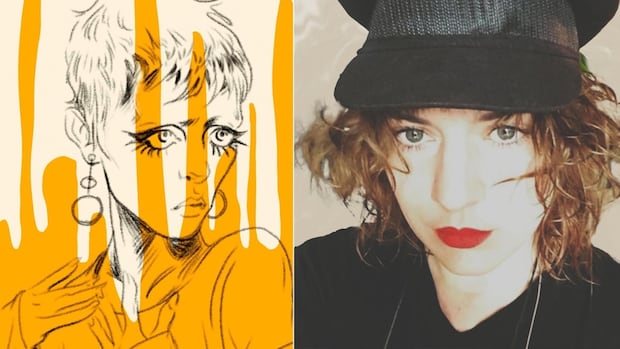Arts·Q&A
Illustrator Katie Sawatsky went from designing games to focusing full-time on comics… and it’s paid off!
Illustrator Katie Sawatsky went from designing games to focusing full-time on comics… and it’s paid off


From designing video games to working in fashion and independent school admissions, Katie Sawatsky has worn many hats. But for the Toronto-based illustrator, it has always begun (and will continue) with comics.
Sawatsky has worked with Netflix, IDW, Image Comics, as well has developed her own projects including Slow Mosey, a psychedelic western comic book. She also just released a new graphic novel called Blackmouth with writer Kyle J. Smith, which is a dark fantasy filled with mystery, witchcraft and murder.
Sawatsky spoke with CBC Arts to talk about how her previous knowledge from designing and developing games came in handy when laying out her and Smith’s new book.
This interview has been edited for length and clarity.
CBC Arts: Tell us how you got into both comics and the gaming industry.
Katie Sawatsky: Games, comics and storyboard [artistry] and animation seem to have a lot of overlap in our industry. I started in comics, and I [met] a lot of game artists and people that were doing comics as a secondary gig. I’ve always had an interest in gaming and programming, and I decided at one point that I wanted a steadier job than freelance comic book stuff. I interviewed at a gaming company and managed to secure the gig, and I worked there for many months until they restructured. I worked again at a startup gaming company where I wore many, many hats, but we never shipped a thing.
That’s actually when I decided to go back into comics full time instead of splitting my talents. I haven’t abandoned games… but most of my efforts are now into comics and graphic novels.
Speaking of wearing many hats, you also have a background in fashion. How does that come into play specifically with art and design?
My interest in fashion is in the craftsmanship and the expressiveness of it. I think that really plays into my approach to drawing. I don’t like working on licensed properties as much as I like working on my own stuff. I like doing things differently every time; keep things moving and always questioning my style and the way I render stuff, which really relates to fashion and the way it tends to move through trends. I find change is the most stimulating thing in art.
For Blackmouth, you and your collaborator, writer Kyle J. Smith, said that you were excited by how the story is told, taking influences from games like Elden Ring. Can you tell me how that comes into play when writing a graphic novel?
Kyle works in film and television and he is a huge movie buff. I could tell right away when I met him that he knew how to write and he knew how to express that story to me as a potential artist in its most exciting form.
Instead of telling me what happened, he told me where, why and what the themes were, and what the vibe is. We both are really into what is currently just labeled as “vibe” as atmosphere. It’s that kind of atmospheric and environmental storytelling that plays a huge role in video games, especially to help the player navigate the virtual world that’s been built.
[Besides] the formal aspect of making comics — like breakdowns and panels and the logical movement of the reader’s eye — there are background elements or that extra layer of sauce you put on something like drawing smoke, obscuring the sun and buildings themselves are covered in soot. You take everything to another level and you start creating believable and living worlds.
All those elements add to the book’s gothic horror atmosphere. Why do you find that theme so compelling?
It is having a moment, but it’s quite perennial. Even when I was younger, I was more interested in darker themes as opposed to lighter themes. I think you have to look a little bit harder at those themes because by their nature, there is trickery there. The world is not what you’re being told it is, it’s what you’re experiencing it to be. And that’s a real visceral reaction that kids have… It taps in on some really basic emotions, but it can be a sophisticated genre to tell stories.
Katie Sawatsky will be at FanExpo Canada at the Metro Toronto Convention Centre (255 Front St. W.) in Toronto, Aug. 21-24.
ABOUT THE AUTHOR

Michelle Villagracia is a writer and producer for CBC Life and CBC Arts who loves to bake and uses movie quotes to express real human emotions. She also tries to insert D&D or her cat into every conversation. Follow her on Instagram @mivi3k.
